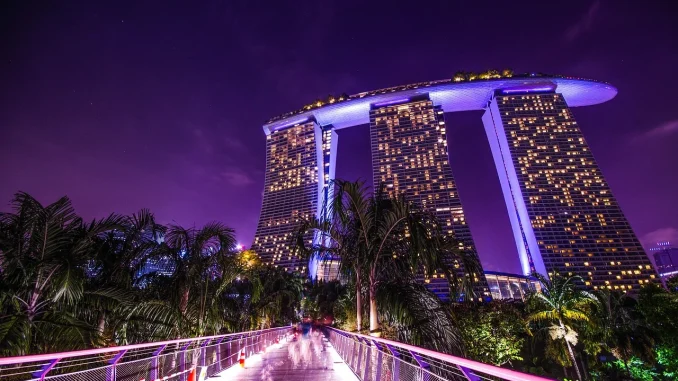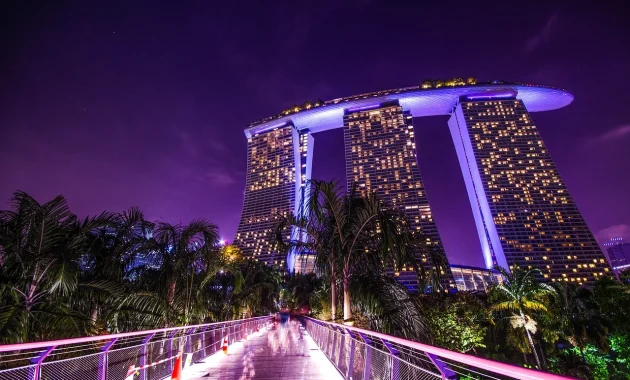
Singapore has long been recognized as the “Garden City,” a nickname earned through its dedication to urban greenery and sustainable development. With a strong commitment to environmental sustainability, the city-state has become a global leader in green living, offering a blueprint for cities worldwide. This article dives into how Singapore integrates sustainability into its urban fabric, from innovative green architecture to forward-thinking government policies.
Sustainable Architecture: Building a Greener Future
Singapore’s approach to architecture is a core component of its sustainability initiatives. The city’s skyline is defined not only by its towering buildings but also by the green spaces woven into its design. From rooftop gardens to vertical green walls, these architectural features are designed to reduce heat, improve air quality, and create an eco-friendly environment.
One of the most notable examples of green architecture is the Marina Bay Sands complex, which integrates sustainability into its iconic design. The towers are equipped with energy-efficient cooling systems, solar panels, and rainwater harvesting systems, helping to reduce energy consumption and conserve water resources. Another iconic structure is Oasia Hotel Downtown, which uses a porous, plant-covered façade to promote natural ventilation and reduce the reliance on air conditioning.
Additionally, the Green Mark Certification Scheme—a green building rating system launched by Singapore’s Building and Construction Authority (BCA)—sets a high bar for sustainable architecture, encouraging the construction of buildings that meet stringent energy efficiency and environmental sustainability standards.
Smart City Initiatives: Integrating Technology for Sustainability
Singapore’s smart city initiatives are an integral part of its sustainability efforts. By leveraging data analytics, IoT (Internet of Things), and other advanced technologies, the government aims to create a city that is not only liveable but also highly sustainable.
One such initiative is the Smart Nation Program, which integrates sensors and data analytics to monitor and manage resources such as water and electricity more efficiently. These technologies enable real-time tracking of energy consumption, optimizing the way resources are used across the city. The Singapore Power Grid is also a notable example, where advanced metering infrastructure allows residents to monitor their energy use, encouraging smarter, more sustainable habits.
Waste management systems have also seen a tech-driven upgrade. The implementation of pneumatic waste collection systems in housing estates enables efficient waste segregation and reduces the need for manual labor, contributing to a cleaner and more sustainable environment.
Public Transport: A Green Mobility Hub
Transportation is a significant contributor to carbon emissions globally, but Singapore is tackling this challenge head-on with a comprehensive public transport system that is efficient, affordable, and environmentally friendly.
Singapore’s Mass Rapid Transit (MRT) system is a prime example of green urban mobility. With a focus on expanding its reach and making public transport the most convenient choice, the government has significantly reduced the need for private car ownership. MRT stations are integrated with bus terminals, creating seamless transfers that make public transport the default option for many residents. Additionally, the government has introduced electric and hybrid buses to its fleet, reducing the reliance on fossil fuels.
To further incentivize green mobility, Singapore also encourages cycling and walking. The city has invested heavily in infrastructure such as cycling paths and pedestrian walkways, creating a more walkable and cycle-friendly urban environment. The Park Connector Network (PCN), a system of green corridors, allows residents to cycle and walk between parks and nature reserves, promoting healthier lifestyles while reducing the city’s carbon footprint.

Green Spaces: Biodiversity and Urban Living
Singapore’s commitment to sustainability extends beyond technology and infrastructure—it also includes a deep respect for nature and biodiversity. The city-state’s dedication to urban greenery is unparalleled, with nearly half of its land area covered in green spaces. This includes public parks, nature reserves, and urban farms, which collectively improve air quality, provide recreational spaces, and support local ecosystems.
One of the crown jewels of Singapore’s green spaces is the Gardens by the Bay, a 101-hectare nature park located in the heart of the city. This futuristic garden is not only a popular tourist destination but also a vital part of Singapore’s green strategy. The Supertree Grove, a series of towering vertical gardens, captures solar energy and helps cool the park’s conservatories, making it a marvel of eco-engineering.
The Singapore Botanic Gardens, a UNESCO World Heritage Site, is another key player in the city’s green infrastructure. It serves as a living repository of tropical flora, contributing to global biodiversity conservation efforts.
In addition to public parks, Singapore has introduced urban farming projects such as Sky Greens, the world’s first commercial vertical farm. These farms use significantly less water, energy, and land compared to traditional farming, providing a sustainable solution to the city’s food security challenges.
Water and Energy Conservation: Pioneering Sustainability Solutions
Singapore’s approach to water and energy conservation is another area where the city shines in sustainability. Despite having limited natural water resources, the city-state has pioneered innovative solutions such as the NEWater program, which recycles wastewater into clean, potable water. This closed-loop system is a model for water sustainability in other cities facing water scarcity.
In terms of energy, Singapore has embraced renewable energy sources, such as solar power, to meet its growing energy demands. The government has set ambitious targets to increase the use of solar energy in the coming years, making it a critical component of the city’s green energy strategy. The installation of floating solar farms, like the one at Tengeh Reservoir, exemplifies Singapore’s innovative approach to harnessing renewable energy while optimizing land use.
Government Policies: Steering Sustainability for the Future
Behind Singapore’s successful sustainability model is a set of forward-thinking government policies. The Singapore Green Plan 2030, for instance, outlines a comprehensive roadmap for sustainable development over the next decade. This plan sets ambitious targets, including the goal to quadruple solar energy deployment, reduce waste sent to landfills by 30%, and promote energy-efficient buildings.
The government also incentivizes sustainable practices through a variety of grants and subsidies, encouraging businesses and citizens alike to adopt greener habits. The Carbon Pricing Act, introduced in 2019, places a tax on greenhouse gas emissions, further driving industries toward sustainable solutions.
Moreover, Singapore’s Zero Waste Masterplan outlines strategies for reducing waste and improving recycling rates, helping the city to achieve its goal of becoming a zero-waste nation.
Conclusion: Leading the World in Sustainability
Singapore’s commitment to sustainability is evident in every aspect of its urban development, from architecture and public transport to green spaces and innovative technologies. The city’s holistic approach to sustainable living serves as a model for the world, proving that economic growth and environmental stewardship can go hand in hand. As cities around the globe look for ways to combat climate change and reduce their environmental footprint, Singapore’s pioneering efforts offer a roadmap to a greener future.